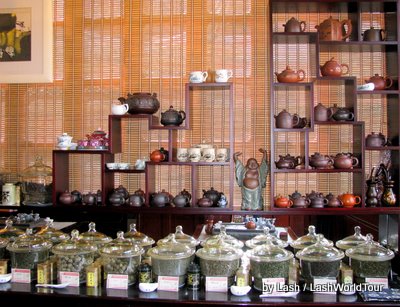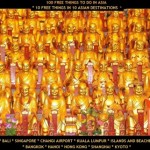Welcome! If it’s your first time here, you might want to subscribe to free monthly newsletters —–>>
 Pudong- Shanghai-China |
|
10 FREE THINGS TO DO IN SHANGHAI, CHINA
China is in a mad race to catch up with the western world in terms of economic prosperity and modern lifestyle. Despite still officially being a Communist nation, the Chinese have embraced capitalism with a fury. Everywhere Chinese are busily erecting skyscrapers, factories, tall apartment buildings, bridges, and cities.
Amidst all the fury, probably the most modern-obsessed city in all of China is Shanghai. In fact, Shanghai’s romance with western culture began back in the 1020s and 30s, when it was known as the ‘Great Athens of China’.
 different levels of Shanghai: old town, tall apartment buildings, world’s tallest skyscrapers |
|
As a result, Shanghai is a fascinating place to visit. The city is packed with amazing architecture, excellent museums, and a few remaining spots of traditional Chinese life squeezed in amidst the towering sky scrapers.
Unfortunately for budget travelers, Shanghai, and China in general, are getting increasingly more expensive. Luckily, Shanghai offers some fantastic free activities which will help offset the costs of visiting this exciting city.
 another view of Pudong’s buildings from The Bund |
|
1. Stroll along The Bund
Shanghai, along with HK, is one of the most western-influenced cities in China. Back in the 1920s-40s wealthy Europeans and Americans built hefty stone banks and hotels along the Pu River, making Shanghai a new financial hub in Asia and attracting wealthy world travelers. Most of these imposing buildings still stand, lining the Puxi promenade.
Today The Bund, as the riverside area is called, is one of the most famous and popular spots in Shanghai, especially now that Pudong district, directly across the river, is packed with an array of unusual, beautiful, futuristic skyscrapers and architectural wonders, like the controversial Oriental Pearl TV Tower.
Stroll along the Bund to marvel at architecture, people-watch, and try your luck at avoiding the plentiful street sellers pedaling fake watches, purses, pens, dvds, and more. Don’t forget to check out the stately original bank buildings lining the Bund- behind you.
2. Wow yourself at one of Shanghai’s highest city views
The lobby of Shanghai Grant Hyatt is perched on the 54th floor of Jin Mao Tower, the world’s 2nd tallest skyscraper until 2008, when the Shanghai World Financial Center (SWFC), just next door, was completed and surpassed it in height by 71 M.
The Grand Hyatt’s 54th floor also has the Grand Cafe Restaurant just beyond the lobby. Floor to ceiling windows line the entire 54th floor, providing literally breath-taking views of Shanghai, including the many neighboring skyscrapers, the meandering Huangpu River, The Bund, and the rest of Shanghai stretching into the distance.
Once SWFC opened in 2008, Hyatt quickly installed its Park Hyatt Hotel on floors 79-93, an even more glamorous version of the Grand Hyatt, if that’s possible. The Park Hyatt’s lobby and Dining Room Restaurant are located on the 87th floor, making it the highest hotel lobby in the world. SWFC is currently ‘only’ the 4nd tallest building in the entire world.
Naturally, ‘potential hotel guests’ are allowed to visit the hotel lobby to inquire about rooms and to dine at the restaurant. This gives you a superb chance to enjoy the Hyatt’s stunning views entirely for free.
At ground level locate the elevator to the Hyatt and zoom up to the lobby (don’t get dizzy!) to take advantage of two of the very best high-rise views of Shanghai. Hotel staff are accustomed to people gazing out the windows, so you’ll blend right in.
While you’re there, ask about room prices, request to see a room, tour the luxurious spa, and scope out the fitness center, if you’re so inclined. You may as well at least see how the ‘better half’ live if you can’t quite afford it yourself at the moment.
(Personal secret: Checking out luxury hotels is one of my favorite travel hobbies.) :))
3. ‘Break’ your neck gazing up at 2 of the world’s tallest skyscrapers
When you visit the Hyatt Hotels at Jin Mao Tower and/or Shanghai World Financial Center (SWFC), take time to stand on the sidewalks and crane your neck back to search for the very tip top of both buildings.
Jin Mao Tower, at 421 M, is currently the 13th highest skyscraper in the world. SWFC, at 492 M, is now the world’s 4th tallest building. Since SWFC was completed in 2008 only two skyscrapers have been built in the world that surpass its lofty height. (In 2008, Taipei 101 in Taiwan was already taller.)
So, crane your neck back and find out just how incredibly tall two of the world’s tallest buildings are!
(btw: Nearby, the Oriental Pearl TV Tower is 468M high, making it one of the world’s tallest towers, as distinguished from tallest buildings.)
 Yuyuan Gardens |
|
4. Marvel at grand traditional Chinese architecture
Most of China’s astounding traditional architecture, temples, towns, neighborhoods, and culture have been obliterated first by Mao’s Cultural Revolution and, more recently, by the Chinese craze to modernize. Fortunately, a few enclaves of traditional buildings still exist.
The most spectacular in Shanghai is Yuyuan Temple area. It fills several blocks with simply gorgeous 3-story to 8-story traditional buildings with all sorts of amazing detailing like turned-up roofs, gilded signs, latticed railings, red lanterns, and intricately carved woodwork.
The area is filled with shops: tea shops, calligraphy, Chinese medicine, urns, statues, art and other traditional Chinese goods. A few active temples dot the area, including the famous Yuyuan Temple, set beside a pond.
Spend a morning, afternoon, or entire day wandering around Yuyuan’s fascinating alleyways admiring what’s left of China’s former grandeur.
 tea shop in Yuyuan area |
|
5. Sample Chinese Teas
As everyone knows, China is famous for tea. What you might not know is the sheer variety of teas and the subtle differences between them. You also might not know the intricate traditional Chinese process of brewing, serving, and sipping tea. China, of course, is the best place on the planet to learn.
Fortunately, you can easily get started for free at any of Shanghai’s many traditional tea shops. Several are located in Yuyuan, others in Shanghai’s remaining old neighborhoods.
Wander into a tea shop, admire the delicate pots, cups, and tea implements. Most likely, you’ll soon be invited to try some tea. A clerk will help you select a tea to sample or will suggest one to you, then she’ll sit down at her tiny tea-making table to brew you your own personal pot of tea.
Sit down and watch, then enjoy some delicious Chinese tea. Yuyuan is probably the easiest place to try tea in Shanghai since the clerks are likely to speak English.
6. Escape the city in ‘Ancient City Park’
Shanghai has several parks where residents escape the hectic, noisy city to practice Tai Chi, play majong, sip tea, and stroll around lakes and landscaped gardens.
Probably the easiest park to reach is just down the road from Yuyuan Temple area. Lovely, peaceful Ancient City Park offers bamboo forests with winding paths and benches, a small serene lake, landscaped gardens, and a wide grassy lawn.
Choose where you prefer to relax and unwind, or visit them all.. It’s a great retreat after bustling Yuyuan.
7. Take a modern architectural tour
Shanghai has some incredible, creative, futuristic-looking
modern architecture splashed around the city. Indeed, Shanghai is one of the best places in Asia to marvel at modern architecture.
One unusual, curious feature I noticed on many of Shanghai’s modern buildings are glass spheres. Another popular feature is spaceship-looking spires and discs. Keep your eye out for them. On the Pudong side, check out Jin Mao Tower, Shanghai World Financial Tower, Oriental Pearl TV Tower, the World Trade Center and see what else you can find.
On the Puxi side, check out several museums set around People’s Square and various towers, spires, and smaller modern buildings between there and The Bund.
8. Gape at Chinese youth fashions and hair styles
A few blocks southeast of the Modern Art Museum is Shanghai’s district for hair salon supplies. Dozens of shops, selling hair products, hairdressing equipment, hair pieces, scissors, and salon furniture, fill up four blocks.
Unless you’re a hairdresser, the shops themselves probably won’t hold much interest for you. But the customers could be of great interest. They are mostly Chinese youth sporting all kinds of wild, flamboyant, interesting coifs and outfits. Go there to discover what Chinese youth currently consider trendy.
The area is located just south of Raffles City Mall on Fu Zhon Lu. Guandong Road borders the area on the south. You can simply stand on the corner near Raffles and People’s Square and watch kids wander by, or else go stroll through the neighborhood yourself.
They’re full of meandering alleys, old one-story and two-story houses with clay roofs, locally-owned shops, traditional Chinese restaurants, and people bustling about, often still wearing their pajamas.
You’ll see all sorts of new things and spend your day wondering what the heck you’re looking at. Fun!
During the past decade, the charming old stone buildings of Taikang Lu have been undergoing renovations and given a new life as they’re transformed into a variety of boutiques, art galleries, coffee shops, and restaurants. Many are owned by western expats or a western-Chinese partnership.
Most sell Chinese art, fabrics, teas, fabrics, and fashions. Others sell art, handicrafts, or fashions from overseas. All are a bit upscale and trendy, and there’s a definite international flavor and fusion to this intriguing area.













 Hi! I'm Lash, an American nomadic world traveler who's been traveling solo since 1998. I’m passionate about traveling the world nomadically and then sharing it all with you. I hope to inspire you to travel the world, to entertain you with tales from the road, and to help you reach your travel dreams. Welcome!
Hi! I'm Lash, an American nomadic world traveler who's been traveling solo since 1998. I’m passionate about traveling the world nomadically and then sharing it all with you. I hope to inspire you to travel the world, to entertain you with tales from the road, and to help you reach your travel dreams. Welcome! 




9 pings
Skip to comment form ↓
DISPELLING MISCONCEPTIONS ABOUT CHINA - LashWorldTour » LashWorldTour
2012/02/29 at 3:05 am (UTC 8) Link to this comment
[…] of a place, then find out you were wrong? If so, share your story! You might also like:10 Free Things to do in Shanghai Life in Shanghai Acquiring a Shou Ma Cycling in Shanghai Curiosities of Shanghai2012 Calendar: […]
ACQUIRING A SHOU MA - LashWorldTour » LashWorldTour
2012/02/29 at 3:05 am (UTC 8) Link to this comment
[…] any stray cats or dogs?You might also like:Life in ShanghaiCuriosities of ShanghaiCycling Shanghai10 Free Things to do in Shanghai.nrelate_popular .nr_sponsored{ left:0px !important; } /* Leave a Reply Cancel replyYour email […]
CULTURAL INSIGHTS: CURIOSITIES OF SHANGHAI - LashWorldTour
2012/06/15 at 10:11 am (UTC 8) Link to this comment
[…] Share your discoveries! You might also like: Life in ShanghaiCycling in Shanghai10 Free Things to do in ShanghaiPhoto Gallery: Shanghai’s Old NeighborhoodsPhoto Gallery: Yuyuan Temple Area, Shanghai […]
10 FREE THINGS TO DO IN HONG KONG - LashWorldTour » LashWorldTour
2013/08/02 at 8:40 pm (UTC 8) Link to this comment
[…] in my series ’1o Free Things to do in…’ : in Kyoto, Japan in Hanoi, Vietnam in Shanghai, China and: Photo Gallery: Boats in Hong […]
10 FREE THINGS TO DO IN KYOTO, JAPAN part 2 - LashWorldTour » LashWorldTour
2013/08/03 at 10:51 am (UTC 8) Link to this comment
[…] Shanghai, China […]